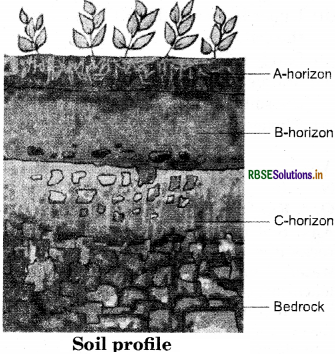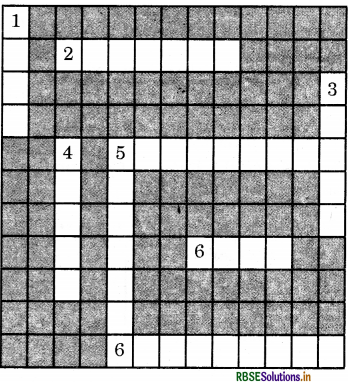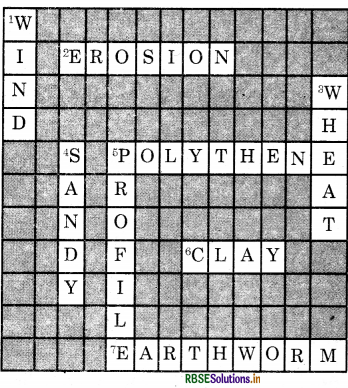RBSE Solutions for Class 7 Science Chapter 9 Soil
Rajasthan Board RBSE Solutions for Class 7 Science Chapter 9 Soil Textbook Exercise Questions and Answers.
Rajasthan Board RBSE Solutions for Class 7 Science in Hindi Medium & English Medium are part of RBSE Solutions for Class 7. Students can also read RBSE Class 7 Science Important Questions for exam preparation. Students can also go through RBSE Class 7 Science Notes to understand and remember the concepts easily. The class 7 science chapter 4 heat extra questions are curated with the aim of boosting confidence among students.
RBSE Class 7 Science Solutions Chapter 9 Soil
RBSE Class 7 Science Soil InText Questions and Answers
Page 97
Question 1.
I wonder why I found some pieces of plastic articles and polythene bags in the soil sample collected from the roadside and the garden.
Answer:
Plastic and polythene in the soil sourced from these areas indicate the uninhibited use and disposal of food packet, mineral water bottles, cany bags etc. by the public in that area.

Page 99
Question 2.
I want to know: What kind of soil should be used for making matkas and surahis?
Answer:
As clayey soil have the best binding property. So, clayey soil would be best for making these items.
Page 100
Question 3.
Boojho wondered why there was a difference in the absorption of water in the two squares.
Answer:
Because the squares of kaehhi road have soil particles which have space between them and can absorb the water. Whereas the square of floor is made up of concrete or cement in which particles are well packed and cannot absorb water.
Page 104
Question 4.
What is the difference between rate of percolation and the amount of water retained?
Answer:
Rate of percolation refers to the rate at which water moves through a soil type. It is measured in mL / min. Amount of water retained refers to the amount of water absorbed by a given quantity of soil. It is measured in mL / g.
RBSE Class 7 Science Soil Textbook Questions and Answers
Tick the most suitable answer in questions 1 and 2 :
Question 1.
In addition to the rock particles, the soil contains:
(i) Air and water
(ii) Water and plants
(iii) Minerals, organic matter, air and water
(iv) Water, air and plants
Answer:
(iii) Minerals, organic matter, air and water.
Question 2.
The water holding capacity is the highest in:
(i) Sandy soil
(ii) Clayey soil
(iii) Loamy soil
(iv) Mixture of sand and loam
Answer:
(ii) Clayey soil.
Question 3.
Match the items in Column I with those in Column II:
|
Column I |
Column II |
|
(i) A home for living organisms |
(a) Large particles |
|
(ii) Upper layer of the soil |
(b) All kinds of soil |
|
(iii) Sandy soil |
(c) Dark in colour |
|
(iv) Middle layer of the soil |
(d) Small particles and tight packed |
|
(v) Clayey soil |
(e) Lesser amount of humus |
Answer:
|
Column I |
Column II |
|
(i) A home for living organisms |
(b) All kinds of soil |
|
(ii) Upper layer of the soil |
(c) Dark in colour |
|
(iii) Sandy soil |
(a) Large particles |
|
(iv) Middle layer of the soil |
(e) Lesser amount of humus |
|
(v) Clayey soil |
(d) Small particles and tight packed |
Question 4.
Explain how soil is formed?
Answer:
Soil is formed by the weathering of rocks due to fast blowing winds, running water, glaciers, high temperatures, leaching of chemicals as well as degradation by some biological factors. This process takes thousands of years to complete. Sometimes, the decomposed parts of dead plants or animals get mixed up with the soil, forming the organic component of soil.
Question 5.
How is clayey soil useful for crops?
Answer:
Clayey soil is very fine in nature. As a result it has poor drainage. This prevents the leakage of its minerals components. It can retain a good amount of water. It is rich in humus. These properties make clayey soil useful for growing crops.
Question 6.
List the differences between clayey soil and sandy soil.
Answer:
Differences between clayey soil and sandy soil.
|
Property |
Clayey soil |
Sandy soil |
|
1. Particle size range |
Very small, invisible to the naked eye. |
Large, easily visible. |
|
2. Aeration |
Poor. |
Good. |
|
3. Water retention |
Good. |
Poor. |
|
4. Drainage |
Poor. |
Good. |
|
5. Fertility |
Very high in humus/organic matter. |
Not very high in humus / organic matter. |
|
6. Areas |
Desert areas |
Coastal areas. |
Question 7.
Sketch the cross - section of soil and label the various layers.
Answer:


Question 8.
Razia conducted an experiment in the field related to the rate of percolation. She observed that it took 40 min for 200 mL of water to percolate through the soil sample. Calculate the rate of percolation.
Answer:
Quantity of percolated water = 200 mL;
Time taken = 40 min
The rate of percolation is 200/40 = 5 mL/min.
Question 9.
Explain how soil pollution and soil erosion could be prevented?
Answer:
Prevention of soil pollution:
- Plastics being non - biodegradable, should be disposed off in separate containers. Their use should be minimised.
- Industrial wastes and other chemicals should be properly treated before releasing into the soil.
- One should avoid indiscriminate use of pesticides, insecticides and chemical fertilizers.
Prevention of soil erosion:
- One should try to prevent deforestation.
- Participate in planting trees as their roots stabilize soil.
- Adopting better farming practices such as crop rotation and contour farming that reduce runoff.
- Creating diversion structures to direct the path of water flow along a desired path.
Question 10.
Solve the following crossword puzzle with the clues given:
Across:
2. Plantation prevents it.
5. Use should be banned to avoid soil pollution.
6. Type of soil used for making pottery.
7. Living organism in the soil.
Down:
1. In desert, soil erosion occurs through.
3. Clay and loam are suitable for cereals like.
4. This type of soil can hold very little water.
5. Collective name for layers of soil.

Answer:
Across
2. EROSION
5. POLYTHENE
6. CLAY
7. EARTHWORM
Down
1. WIND
3. WHEAT
4. SANDY
5. PROFILE


- RBSE Class 7 Science Notes in Hindi & English Medium Pdf Download
- RBSE Class 7 Science Important Questions in Hindi Medium & English Medium
- RBSE Solutions for Class 7 Science in Hindi Medium & English Medium
- RBSE Class 7 Science Important Questions Chapter 1 Nutrition in Plants
- RBSE Class 7 Science Notes Chapter 1 Nutrition in Plants
- RBSE Class 7 Science Important Questions Chapter 14 Electric Current and its Effects
- RBSE Class 7 Science Important Questions Chapter 13 Motion and Time
- RBSE Class 7 Science Important Questions Chapter 2 Nutrition in Animals
- RBSE Class 6 Science Notes Chapter 8 शरीर में गति
- RBSE Class 7 Science Notes Chapter 18 Wastewater Story
- RBSE Class 7 Science Notes Chapter 17 Forests: Our Lifeline